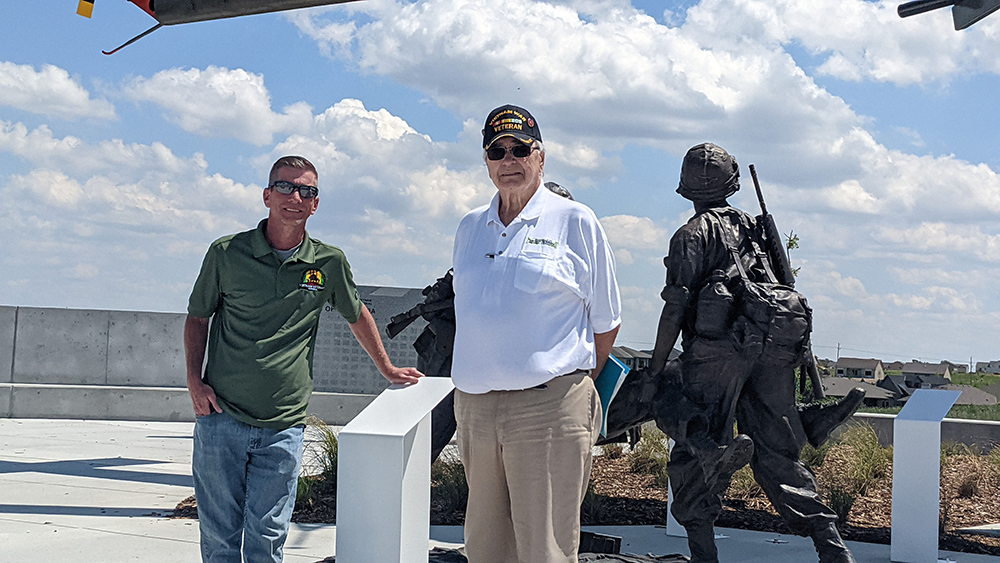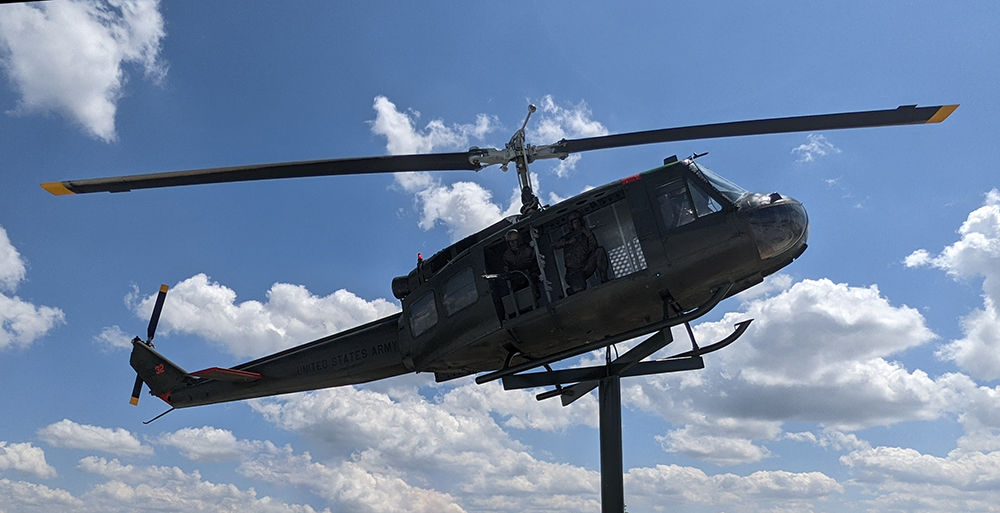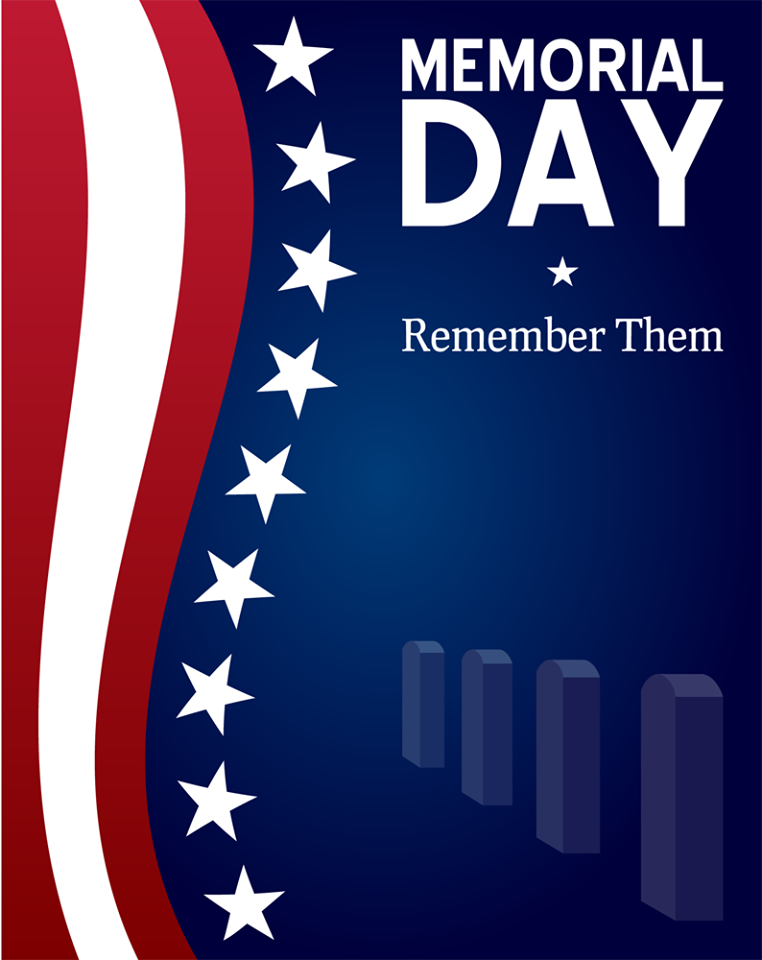PapillionBusinesses.com Interviews Tom Brown (President) and Ron Elwell (Executive Director) of the Nebraska Vietnam Veterans Memorial Foundation.

Nebraska Vietnam Veterans Memorial in background with Ron Elwell (left) and Tom Brown (right)
Tell me about the helicopter the statue there to the helicopter.
Tom: One of the major staples of the war in Vietnam was the helicopter. We were fortunate enough to meet Ron. We were doing a fundraiser in Papillion at the Fairfield Inn in there and Ron was there. He was there for the fundraiser. And we were sitting there talking, myself and George Abbott who was our secretary treasurer, and Ron came over and just started talking.
Ron has a tremendous amount of experience working with helicopters and was a helicopter pilot.
Tom: Why don’t you inform our lady here a bit about the helicopter because you did so much of the work on rehabbing the helicopter.
Ron: So, the day I met these guys, I had been retired from the Army. I retired after twenty-two years. I moved back to home. I was from Papillion and moved back and my buddy would always introduce me as a 22-year-old veteran.
So, I introduce myself, “Welcome home and thanks for what you did for me.”
Tom looked at me and asked, “What did you do in the Army?”
I said, “I worked on helicopters.”
He said, “Huh? We have a helicopter. Do you think you could help us?”
And I was like, “Yeah, sure. I started off with Hueys and Cobras.”
He’s like, “We got a Huey.”
We ended up exchanging numbers. They got a hold of me. [We] call the guy and went to look at the helicopter. I was overwhelmed. The helicopter looks nothing like he does right now. It was in shambles. The tail was cut off with a saw.

Photograph Courtesy of Nebraska Vietnam Veterans Memorial Fund, Damaged helicopter with tail sawed off being moved through mud
Why?
Ron: That’s how they transported it.
Tom: They had to get it on a truck and it wasn’t going to fit with that tail on it there, so they cut it.
Ron: Except there were only 4 bolts on there. They could have removed them, so it was no big deal. But that was a big deal. It didn’t have rotaries. It did not have a transmission … It was just pretty much just a shell of a helicopter.
Tom: . . . and don’t steal it because it ain’t got an engine!
Ron: So I was pretty overwhelmed. And it [helicopter] was at Iowa Western. The director of aviation maintenance program was kind of taking the lead on it. He’s like, “I don’t know first thing about helicopters.”
“That’s all right,” I said, “we’ll work through it.”
He actually was using a model kit. He was using the instructions as to how the helicopter was supposed to go together. He was using some of the Iowa Western students to help restore it. So, about a year?
Tom: Yes.
Ron: Right, about a year.
Got it all hemmed up, put it all together and it is what you see today, in midway . . . in between getting it fully restored. We’ve probably, I would say, there’s probably, easily, ten thousand hours in building the helicopter and to get back together between all the manpower we used.
About midway when we were getting done, we get a phone call from George Abbot. He said, “Hey, what’s the full tail number for the aircraft? [Do you] have a tail number to the helicopter?”
I said, “Well, 68-15532.”
He’s like, “I think we found the original crew chief from 1968!”
No way!
Tom: Yes, way!
Ron: I said, “George, your full of it. There’s no way. I don’t believe that.”
He’s like, “I am telling you. I need you to contact this guy and vet him and see if he’s the real deal.”
Well, there’s a lady that runs our education history committee Her name is Dottie Barickman. And I called her and she said, “Oh yeah, this guy has logged journals, over a couple 1000 pages of journals and over a couple of 1000 pages of pictures.”
Tom: He recorded everything while he was there.
No way
Tom: Everything.
Ron: So, he was the original crew chief. Come to find out all the original crew members were still alive. This helicopter only had about 3500 hours on it from his time in Vietnam. Well, Craig, the original crew chief, got this helicopter on his birthday, May 4th of 1968, on his 21st birthday. He got this helicopter because his was blown up. He’s got pictures of receiving his helicopter. He flew it for a year and a half because he, like Tom, extended six months and all the other guys had flown it multiple times. There’s only one of them no longer living. He died from complications from Agent Orange before he could see it.
We finished that. We had all agreed that it’s probably a good idea to do a reveal for them they had not seen the helicopter in more than 50 years.
Nor had they been together in fifty plus years. We did make a big deal of it. They all flew out came in and they saw the helicopter for the first time, completely redone as you see today.
Originally, the plan was to make it a medevac and show it medically lifting somebody. When we figured out the story was, “Hey, this helicopter was not a medevac. It was a command-and-control bird.” I had him send me all the pictures on this aircraft and I painted it just like it was in 1968 including the nose arc with Snoopy. So, everything is just like it was in 1968. I’m still doing a little bit of work, I’ve got to do here next week, but it looks just like it did in 1968 when he got the helicopter.

Restored helicopter mounted on pole at the Nebraska Vietnam Veterans Memorial
Congratulations. It’s amazing
Ron: The whole crew will be out here. The whole crew’s coming out here minus the one, he passed away from Agent Orange complications, but his family will be out here for the dedication. They’ve seen it once. They had not seen it, not up on a pole like it is, so it’s a pretty, pretty big deal.
That was a pretty emotional day when we revealed the helicopter for them to just be able to sit in it for the first time in 55 some years. But it’s truly made it worth every ounce of effort for what we put into the helicopter.
The statues are all modeled after some of the Air Force personnel from Offutt. Those are all actual people, airmen from Offutt that came out to do the modeling. The gun that’s mounted in there, that was an addition because the medevac didn’t have guns.
When we figured out command and control, I had the sculptor [make a] mock up and we got measurements for the original guns, so they mocked all that out. It’s all exactly the way it worked, like in 1968.
There are two pilots up front inside there. There are those statuaries there and there’s a sound system. It’s not working yet. It’s installed. We are just waiting on a part and you’ll be able to hit the button and you’ll hear the Huey actually hovering over top of top of you. If you ask any Vietnam veteran, they will tell you the Huey sound is very iconic. And to this day, most Vietnam veterans can tell you when a Huey is 3, 4, 10 miles out and they can hear that sound and just know that it is a Huey to come out and get them.
We incorporated the sound and started making the lights work. Me and the guy from Iowa Western decided, we are like, “Hey, let’s make all the lights work,” so we did! We made them all work and put it all back together. On January 31, it moved here. About two months later we mounted it on the pole.
We made some adjustments on the rotors, so they don’t fly. We’ve adjusted a lot of stuff to make sure that it’s not trying to lift off, just minor things. The helicopter’s attracted a lot of attention.
Tom: Why don’t you tell the lady how it got here?
Ron: Yes
Tom: We’ve got a story behind how we actually got the helicopter.
Ron: So these guys . . . I always like to tell when they came up with this idea … they were drinking a beer . . .
Tom: . . . or two.
Ron: . . . and telling war stories and just had a good idea. Tom knows most Vietnam veterans throughout the entire nation. He’s got a connection to somebody somewhere in any state. I would probably say, probably the world at this point, but Tom had a friend. Was it at the VFW?
Tom: Vietnam Veterans of America out of Vermont
Ron: They had this helicopter sitting in Vermont just basically waiting to be restored and they couldn’t figure out how to raise the funds to restore it. Tom was talking to him one day. He’s like, “Hello [I’m] looking for helicopters.”
“Okay, I got like one. You guys want it, come get it. Just pay for transportation. It’s yours.”
Tom is like, “Done, I got that covered.”
Tom: Sold American.
Ron: Again, sitting around drinking a beer. Hey, we’re gonna move that. It was in Bennington, Vermont. They drove up there, loaded it up and drove it back to Bennington in Nebraska.
And then once he got there, he was like, “Well, what do you do with it? How do we get someplace [to be] restored?” When they talked with Iowa Western in Iowa, the guy at Iowa Western jumped on board like, “Hey, well, we’d like to take on that project with our students and try and help out,” so it got moved from Bennington to Iowa Western. That’s where I got involved with it
So, the whole story of that helicopter . . . it’s just every time we turn around, it gets more and more interesting. There are connections right now that we know about that we haven’t or will put out eventually one day in the near future, but there are connections to that helicopter and some of the folks that are memorialized on the wall.
Wow
Ron: That very same helicopter. The connections between that helicopter out there. It’s just unbelievable. One of the pilots, he’s a Silver Star recipient. His nephew actually lives here. They didn’t know about the helicopter. They actually found it from a magazine, DVAs magazine. They saw it. One of the pilots saw sent it to Craig like, “Hey, isn’t that our helicopter?”
He’s like, “Yep, that’s our helicopter.” And they figured out how to get in contact with us which was with Dottie. And from there it was just history. The strange connections seem to just keep happening.
That’s beautiful.
Ron: It’s very beautiful.
Every Vietnam veteran, I don’t care what branch of service they served there, they all know that Huey. They all [know] that significance.
I tell everybody like that was really the first time we used helicopters to the extent that we did was in Vietnam.
Korea, you had a few just as medevacs and stuff, but Vietnam is where we learned how to do helicopter operations. When I was in the Army, when I first got in a lot of our tactics were based off of Vietnam tactics.
That is where it all started with that helicopter right there.
Tom: The two soldiers, that was all done here. But that’s symbolic of what we do in Vietnam, you’re medevacing a wounded soldier. And in Vietnam, that’s how you get your supplies, your food, your ammo.
That’s how you medevac. There were no trucks and stuff like that. You don’t drive trucks through the jungle. That just don’t happen.
Ron: Yeah
Tom: or land mines. It’s not a real good idea.
Ron: All the sculptures have been done by a local artist. He actually helps veterans. His name is Troy Muller.
He’s done a fantastic job with all the sculptures. Most things are Vermont granite which is ironic, that’s where the helicopter is from too.
Everything is locally sourced. Either US sourced or locally sourced. We’re using all the monuments, the engraving and stuff are all done by companies in West Point, Nebraska. And then our memorial honor wall was all the same. The granite, that was the thing that cost the most and took the longest.
Tom: We got a million pounds of granite here.
Wow.
Tom: That relates back about $2 million. Yeah. Yes. It’s a lot of fundraising.
Ron: Each one of those weighs 20,000 pounds apiece.
The twenty-five-foot wall that came out in one section. The quarry flooded when Vermont got flooded. The quarry was completely flooded so they couldn’t get the granite out. So that that held us up a little bit trying to get the granite delivered.
I want to say that 24 foot granite wall, I want to say that being is right at almost 100,000 pounds.
Thank you both very much.
Come and see the Nebraska Vietnam Veterans Memorial for yourself at the ceremony on 6 June!
Get tickets and learn more here:
https://nvvmf.org/
Nebraska Vietnam Veterans Memorial
11691 South 108th Street
Papillion NE, 68046








